Frontiers of Taxonomy: Split the Tropics!

Yellow-billed Tropicbird. © juju98
The internal systematics of the tropicbird family (Phaethontidae) have traditionally been regarded as stable: a trio of distinctive pantropical species. Recently, however, there is an ongoing reassessment of bird classifications received from prior centuries, especially the status of similar but distinguishable forms, now giving higher priority to distinctions and the appreciation of diversity. In this vein, Howell and Zufelt (2019) propose to subdivide White-tailed and Red-billed Tropicbirds into two species each, expanding the family from three species to five. These cases are not equivalent: one is easy and the other is hard—but both proposals have sufficient basis to be accepted.
The Red-billed Tropicbird is the easy case: a quick review of a few good photographs is enough for any observer to see that the Arabian Tropicbird of the Indian Ocean is a different animal from the Red-billed of the Atlantic and Pacific Oceans. Their bills, tails, and facial markings differ conspicuously. The significance of these differences as denoting separate species seems self-evident and should be uncontroversial. Their traditional classification as conspecific appears to be an error of judgment that will inevitably be corrected the next time it is formally reconsidered.
The White-tailed Tropicbird is a much harder case, more of a borderline call. This author was not fully persuaded until discovering that the breeding ranges of Catesby’s and Yellow-billed Tropicbirds overlap, but with no evidence of interbreeding, which implies that they function as separate species. However, this overlap in their breeding ranges has apparently gone unnoticed until now, so it is reported here for what appears to be the first time—details and photos are provided below.
Red-billed vs. Arabian. Red-billed and Arabian Tropicbirds do not occur together and their ranges are so far removed from one another that even occasional contact is unlikely. Adults of the two species differ in four distinctive features:
Tail: Arabian’s tail streamers rarely approach the length of the body, whereas Red-billed’s regularly grow much longer. Red-billed’s streamers are not always long, so short streamers do not rule out Red-billed, but long streamers confirm Red-billed.

Red-billed Tropicbird, showing longish tail streamers, bold black eyestripe, thin all-red bill, and fine barring on the back. (Little Tobago Island, Trinidad & Tobago; January 13, 2020.) © Steven Hunter

Arabian Tropicbird, showing typically short tail streamers, crescent teardrop marking, thick black-edged bill, and relatively coarse barring on the back. (Perumal Par, Lakshadweep, India; January 13, 2015.) © Bijoy Kombarakkaran
Facial Markings: Adult Red-billed has a bold black eyestripe that extends from the eye to the hindcrown. Fully mature Arabian has no eyestripe, but instead has a crescent-shaped black “teardrop” marking. However, subadult and some apparently adult (but presumably young adult) Arabians retain an indistinct blackish eyetripe—somewhat resembling Red-billed’s eyestripe, but lacking its boldness and crisp contrast.
Bill: Arabian’s bill is proportionately shorter and thicker, and it has blackish edges whereas Red-billed’s is all-red.
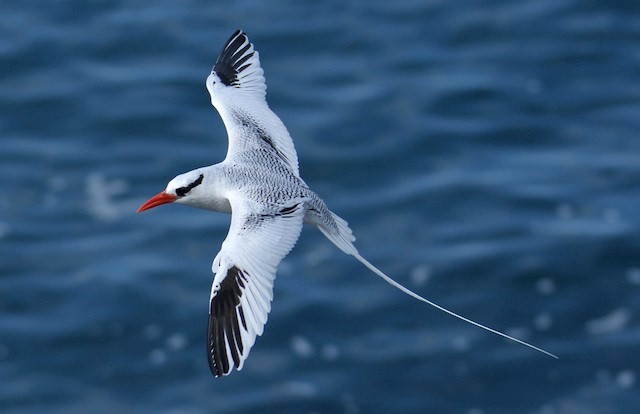
Red-billed Tropicbird, showing longish tail streamers, bold black eyestripe, thin all-red bill, and subtle carpal bars. (Isla Santa Fé, Galápagos, Ecuador; March 24, 2011.) © Jeremiah Trimble

Arabian Tropicbird, showing typically short tail streamers, crescent teardrop marking, thick black-edged bill, coarse barring, and strong carpal bars. (Halulu Island Qatar; October 16, 2010.) © Gavin Farnell
Voice: Arabian and Red-billed also differ in vocal quality. As Howell and Zufelt describe it, Arabian’s voice is “higher and shriekier than Red-billed, less rasping.” Based on publicly available recordings, Arabian’s voice is noticeably higher-pitched and less harsh.
Immature Red-billed and Arabian Tropicbirds are much more similar than the adults, and may be indistinguishable in many cases. The most reliable distinction appears to be bill color and pattern. Immature Arabian’s bill is horn-colored (sometimes pinkish) with distinct blackish edges, whereas Red-billed’s generally appears yellowish and has less distinct blackish edges. As they age their bills tend to brighten differently, with Arabian’s turning rosy-orange and Red-billed’s turning yellowish-orange.

Red-billed Tropicbird, subadult showing thin, unmarked, orangish-yellow bill. (Offshore from Hatteras, North Carolina; June 1, 2017.) © Skip Russell

Arabian Tropicbird, immature showing thick, horn-colored, black-edged bill and strong carpal bar. (Offshore from Vasco da Gama, South Goa, India; November 5, 2017.) © Manjusha Savant
Yellow-billed vs. Catesby’s. Yellow-billed and Catesby’s Tropicbirds are not generally known to overlap, but they do (see evidence provided below). The differences in their appearances are subtle and not absolute, so field identification requires a close study or a clear photo of the upperside of the primaries, and even then it can be inconclusive in some cases.
The difficulty in separating Catesby’s from Yellow-billed is that the White-tailed Tropicbird “complex” (i.e., Catesby’s plus the four or five Yellow-billed subspecies) varies in each of the key features and overall there is a spectrum of variation. In each case, Catesby’s is at one end of the spectrum, but internal variation within and among the several subspecies appears to exceed the difference between Catesby’s and the rest.
Size: Catesby’s averages larger than Yellow-billed, but the largest subspecies of Yellow-billed (lepturus of the Indian Ocean) averages closer to Catesby’s’ size than to the smallest subspecies (dorotheae of the Pacific).
Bill Color: Catesby’s’ bill tends to appear more orange than yellow, especially in breeding adults, whereas most Yellow-billed appear pale-yellow, sometimes greenish-yellow or horn-colored, but a few Yellow-billed show orange bills and Catesby’s often appear yellow, so there is significant overlap in this feature.
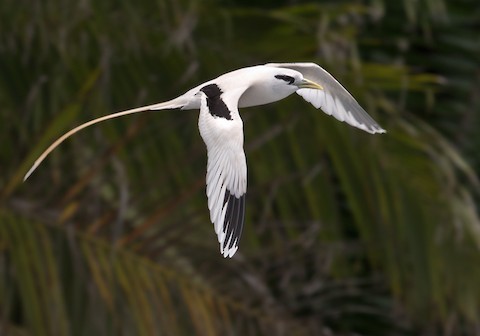
Yellow-billed Tropicbird, P. l. ascensionis, showing typically greenish-yellow bill and somewhat narrow white tips on its outer primaries—but broader than on Catesby’s. (Príncipe, São Tomé & Príncipe; September 23, 2017.) © Lars Petersson

Catesby’s Tropicbird, showing typically orange bill and small amounts of white in the tips of its outer primaries. (Spittal Pond Nature Reserve, Bermuda; March 3, 2019.) © Tim White
Wingtip Pattern: Probably the most reliable distinction is the pattern of black in the outer primaries; however, the difference is subtle and here again Yellow-billed varies internally far more than it differs from Catesby’s. Both have extensive black on the outer primaries. Catesby’s generally has more extensive coverage but the objective difference is the amount of white in the tips of the three or four outermost primaries: an appreciable amount on Yellow-billed versus almost none on Catesby’s. (The difference is consistent but not absolute: some Yellow-billed have very little white at the tip of one or two primaries, and some Catesby’s have appreciable white at the tip of one or two primaries.)
Voice: Howell and Zufelt (2019) treat Catesby’s’ voice as “Clucks and yelps lower than Yellow-billed.” This might be accurate overall, but based on a review of recordings available through the Macauley Library, many vocalizations of Catesby’s and Yellow-billed are extremely similar if not identical.
Judging solely from these observable features, the status of catesbyi seems inherently ambiguous. It is certainly possible to conclude that the White-tailed Tropicbird is internally diverse and that catesbyi represents a minority share of that diversity: in other words, it could be nothing more than a somewhat distinctive subspecies or form.
Catesby’s Tropicbird Breeds in Brazil. It has long been known that Brazil has two breeding populations of White-tailed Tropicbird: a large population in the northeast on Fernando de Noronha and a few pairs in the southeast on the Abrolhos Islands. As ornithological reference works define each subspecies primarily the geography it is thought to occupy, these populations have been presumed to pertain to the South Atlantic subspecies ascensionis.

Catesby’s Tropicbird—note orangish bill and mostly back wingtips—location inferred from the context of the photo’s publication. (Abrolhos Islands, Brazil; February 29, 2016.) © Ademir Carletti
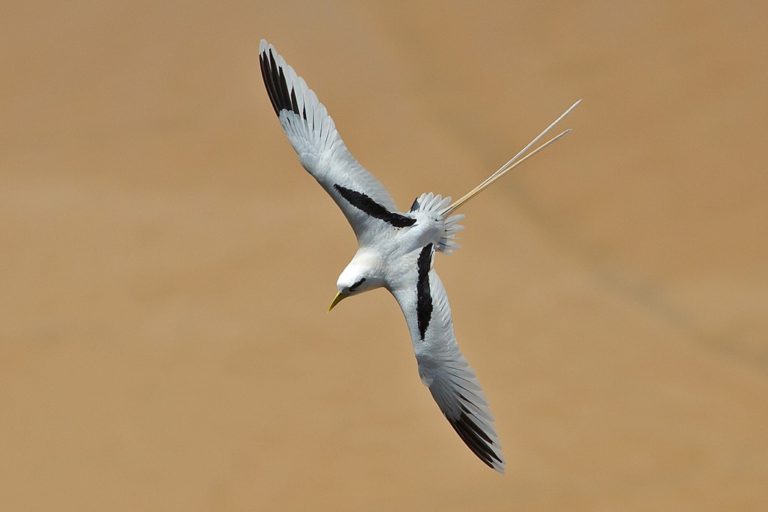
Yellow-billed Tropicbird, P. l. ascensionis, showing typically broad white tips on its outer primaries, but somewhat orangish-yellow bill. (Fernando de Noronha, Brazil; February 21, 2015.) © Rodrigo Conte

Catesby’s Tropicbird—note orangish bill and mostly back wingtips—location inferred from the context of the photo’s publication. (Abrolhos Islands, Brazil; August 27, 2016.) © Fernando Farias
When reviewing photos tagged Phaethon lepturus on the excellent Brazilian bird website Wikiaves, I noticed that all of the photos from the Abrolhos and coastal Bahia have wingtips consistent with catesbyi, but not ascensionis. Of the photos from Fernando de Noronha, 99% of the identifiable individuals have ascensionis’s wingtips, whereas one individual is clearly catesbyi. In addition, several of the photos are not clear enough to evaluate and several are either clearly or probably Red-billed Tropicbirds misidentified by the photographers.

Catesby’s Tropicbird—note rich orange bill—on one of six nests reported here in 2013. (Abrolhos Islands, Brazil; February 2, 2013.) © Robson Czaban
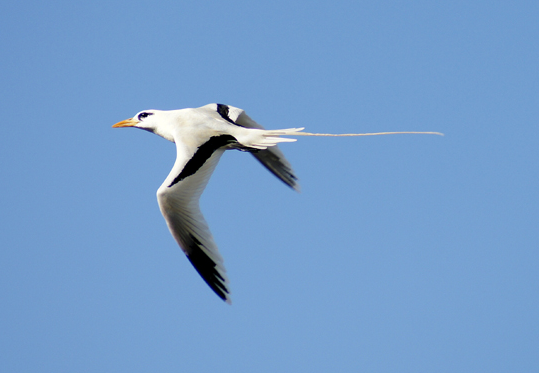
Catesby’s Tropicbird—note orangish bill and mostly back wingtips—location inferred from the context of the photo’s publication. (Abrolhos Islands, Brazil; June 6, 2012.) © Francisco Neto
While far from comprehensive, the results of this review seem conclusive: the tiny Abrolhos population is of catesbyi, which also wanders occasionally to the mainland coast and the Fernando de Noronha, where ascensionis breeds in numbers.
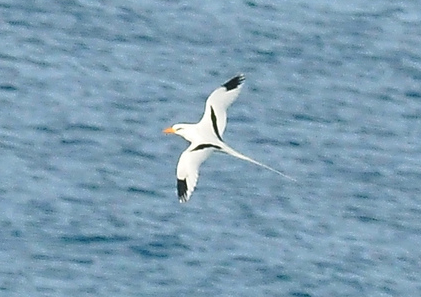
Catesby’s Tropicbird—note mostly back wingtips visible even in this long-range photo. (Abrolhos Islands, Brazil; February 3, 2013.) © Robson Czaban
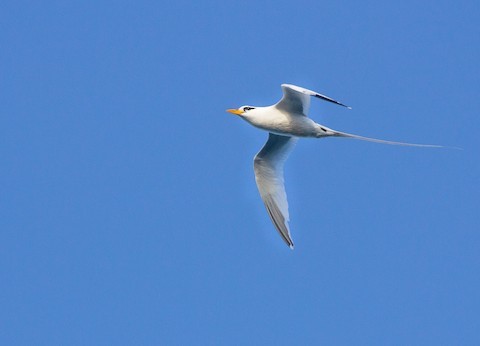
Catesby’s Tropicbird—note orange bill and nearly all-black wingtip visible through the underside of the wing. (Abrolhos Islands, Brazil; July 5, 2014.) © Luana Bianquini
Conclusion: Catesby’s and Yellow-billed Tropicbirds Are Different Species. The global distribution of catesbyi extends from the western North Atlantic and Caribbean south to the waters of southeastern Brazil. Its range therefore effectively includes Fernando de Noronha. Catesbyi and ascensionis overlap not just marginally, but extensively and over an historical time-scale. Yet it seems clear from the distinctness of the two Brazilian nesting populations that catesbyi and ascensionis have maintained overlapping (or at least adjacent and interpenetrating) breeding ranges with no evidence of interbreeding.
Assuming that there are no fundamtental errors in the information presented here, Catesby’s and Yellow-billed Tropicbirds appear to meet one of the generally accepted objective standards for recognition as separate species—sympatric populations that maintain reproductive isolation—so Howell and Zufelt’s recommendation to split them is correct. Q.E.D.

Catesby’s Tropicbird—note barely detectable orange tone in the bill and nearly all-black wingtips. (Fernando de Noronha, Brazil; August 10, 2012.) © Luiz Carlos Ramassotti

Yellow-billed Tropicbird, P. l. ascensionis, showing somewhat narrow white tips on its outer primaries—but broader than on Catesby’s. (Fernando de Noronha, Brazil; August 8, 2012.) © Luiz Carlos Ramassotti
References
Howell, S.N.G., and K. Zufelt. 2019. Oceanic Birds of the World. Princeton University Press.
Le Corre, M., and P. Jouventin. 1999. Geographical variation in the White‐tailed Tropicbird Phaethon lepturus, with the description of a new subspecies endemic to Europa Island, southern Mozambique Channel. Ibis 141:233-239.
van Perlo, B. 2009. A Field Guide to the Birds of Brazil. Oxford University Press.
Wikiaves. 2020. Rabo-de-palha-de-bico-laranja, https://www.wikiaves.com.br/wiki/rabo-de-palha-de-bico-laranja. (Accessed September 1, 2020.)
Text © Russell Fraker / September 1, 2020